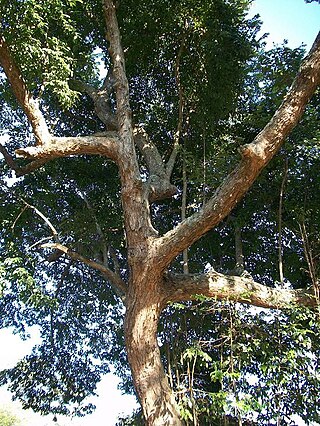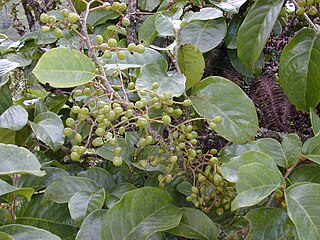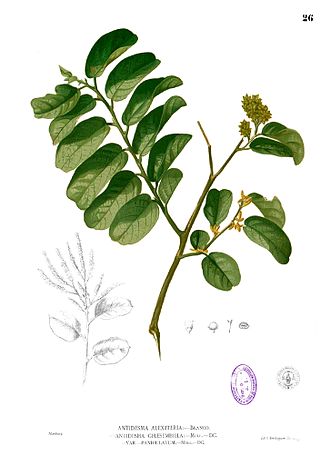
Antidesma is a genus of tropical plant in the family Phyllanthaceae formally described by Linnaeus in 1753. It is native to tropical Africa, S + E + SE Asia, Australia, and various oceanic islands. The greatest diversity occurs in Southeast Asia.

Phyllanthus is the largest genus in the plant family Phyllanthaceae. Estimates of the number of species in this genus vary widely, from 750 to 1200. Phyllanthus has a remarkable diversity of growth forms including annual and perennial herbs, shrubs, climbers, floating aquatics, and pachycaulous succulents. Some have flattened leaflike stems called cladodes. It has a wide variety of floral morphologies and chromosome numbers and has one of the widest range of pollen types of any seed plant genus.

Phyllanthaceae is a family of flowering plants in the eudicot order Malpighiales. It is most closely related to the family Picrodendraceae.

The family Pandaceae consists of three genera that were formerly recognized in the Euphorbiaceae. Those are:

Antidesmateae is a tribe of the plant family Phyllanthaceae. It comprises 5 subtribes and 9 genera.

Aporosa is a genus of flowering plant belonging to the family Phyllanthaceae, first described as a genus in 1825. It is native to China, the Indian Subcontinent, Southeast Asia, Papuasia, and Queensland.
Maesobotrya is a genus of flowering plant belonging to the family Phyllanthaceae first described as a genus in 1879. It is native to sub-Saharan Africa. It is dioecious, with male and female flowers on separate plants.

Margaritaria is a plant genus of the family Phyllanthaceae first published as a genus in 1782. It is the smallest pantropical genus of the Phyllanthaceae and, formerly, of the Euphorbiaceae, widely distributed in tropical and subtropical regions of Asia, Africa, Australia, North and South America, and various oceanic islands.

Antidesma platyphyllum is a species of flowering tree in the leafflower family, Phyllanthaceae, that is endemic to Hawaii. Common names include hame, haʻā, mehame, hamehame, mēhamehame, and haʻāmaile. It inhabits coastal mesic forests, mixed mesic forests, wet forests, and bogs at elevations of 150–1,525 m (492–5,003 ft) on all main islands.
Antidesma cruciforme is a species of plant in the family Phyllanthaceae. It is endemic to Peninsular Malaysia.
Antidesma pyrifolium is a species of plant in the family Phyllanthaceae. It is endemic to Sri Lanka.
Antidesma tomentosum is a species of plant in the family Phyllanthaceae. It is native to Borneo, Java, Peninsular Malaysia, the Nicobar Islands, the Philippines, Sulawesi, Sumatra and Thailand.

Flueggea neowawraea, the mēhamehame, is a species of flowering tree in the family Phyllanthaceae, that is endemic to Hawaii. It can be found in dry, coastal mesic, and mixed mesic forests at elevations of 250 to 1,000 m. Associated plants include kukui, hame, ʻahakea, alaheʻe, olopua, hao, and aʻiaʻi. Mēhamehame was one of the largest trees in Hawaiʻi, reaching a height of 30 m (98 ft) and trunk diameter of 2 m (6.6 ft). Native Hawaiians used the extremely hard wood of this tree to make weaponry.

Antidesma bunius is a species of fruit tree in the family Phyllanthaceae. It is native to Southeast Asia and northern Australia. Its common Philippine name and other names include bignay, bugnay or bignai, Chinese-laurel, Queensland-cherry, salamander-tree, wild cherry, and currant tree.

Antidesma ghaesembilla is a species of plant in the Phyllanthaceae family. It is native to an area from northern Australia to the Philippines, Zhōngguó/China, and west to India. The shrub or tree usually grows in moist soils in plant communities ranging from savannah to gallery forest to closed forest. It is associated with a number of species of fungus, insects and animals, including emus. Amongst the Mangarrayi and Yangman people of north Australia, the sweet ripe fruit of the tree are much appreciated and linked to the build-up season and to the koel. As well as food, the plant is used as a calendar-plant, for dyeing, in traditional medicine, in religious/magical practices, as fuel, and as an insecticide.
Antidesma alexiteria is a species of plant in the family Phyllanthaceae. It was early classified as a genus within family Euphorbiaceae, but later moved into family Phyllanthaceae. It is endemic to Southern India and Sri Lanka. It is a small understory shrub with maximum height of 8m. Fruits are red in color. In Sri Lanka, the plant is known as "Heen embilla - හීන් ඇඹිල්ල", which is used in Ayurvedic purposes. leaves of A. alexiteria are used as an antidote for many snake bites, and bark of the root for dysentery treatments.
Antidesma jayasuriyae, is a species of plant in the family Phyllanthaceae. It is endemic to island of Sri Lanka.

Antidesma japonicum is a shrub in the family Phyllanthaceae. It is found in Southeast Asia, China and Japan. It provides food and fuel. A. japonicum has two accepted varieties: the nominate variety, A. japonicum var. japonicum; and the robustius variety, A. japonicum var. robustius.

Antidesma venosum, commonly known as the tassel-berry, is a species of small dioecious tree in the family Phyllanthaceae. It is native to Africa, China and Indochina.











